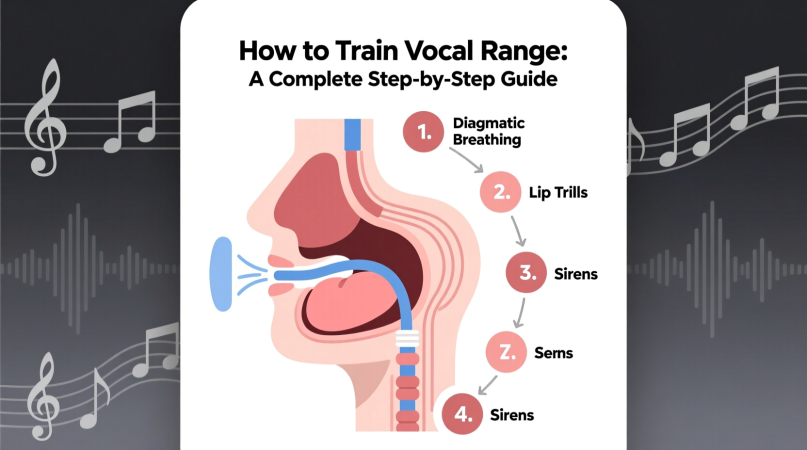
Most singers eventually ask the same question: How can I add more notes to my vocal range? Whether you dream of belting powerful highs, reaching deeper lows, or simply smoothing transitions, the answer lies in consistent vocal range training.
Just like athletes train flexibility and strength, singers can train the muscles and resonance systems that shape their voice. With the right methods, it’s possible to expand your range safely and unlock notes you never thought you could sing.
This guide covers the science, techniques, and routines that make vocal range training effective — plus tips to avoid common mistakes.
What Does It Mean to Train Vocal Range?
Your vocal range is the span between the lowest and highest notes you can sing clearly. Most beginners sit between 1.5 and 2 octaves. With training, many singers expand their range by semitones or even a full octave.
Training your range means deliberately exercising your voice to:
- Strengthen coordination between vocal fold muscles
- Smooth register transitions (chest, head, falsetto, mixed)
- Improve resonance and airflow efficiency
- Build endurance so new notes are usable, not squeaked out once
👉 Before you begin, it’s smart to measure your current range. You can do this with the Vocal Range Test or our vocal range calculator by VocalRangeTest.com. This gives you a baseline to track improvements over time.
The Science of Vocal Range Training
To understand how training works, let’s look at the basics:
- Muscle coordination: Two key muscle groups control pitch. The cricothyroid (CT) muscles stretch and thin the folds for high notes, while the thyroarytenoid (TA) muscles shorten and thicken them for low notes. Range training teaches these muscles to coordinate more efficiently.
- Resonance: The vocal tract (throat, mouth, nasal cavities) acts like a natural amplifier. Adjusting its shape can make high or low notes easier.
- Airflow and pressure: Smooth, controlled breath support is critical. Training helps you balance air and resistance.
Think of vocal range training as a blend of muscle flexibility, breath control, and resonance shaping.
Preparation: Setting Up for Success
Jumping straight into extreme notes can damage your voice. Preparation matters:
- Warm up gently with humming, lip trills, and sirens.
- Check your posture: tall spine, shoulders relaxed, jaw unclenched.
- Use diaphragmatic breathing, not shallow chest breathing.
- Hydrate: sip water often; avoid caffeine or alcohol before training.
- Keep sessions short: 15–20 minutes daily is safer than a once-a-week marathon.
Core Exercises to Train Vocal Range
Here are six tried-and-true exercises singers use:
1. Lip Trills
Blow air through loose lips while sliding through pitches. This exercise balances airflow, reduces tension, and preps your folds for range work.
2. Sirens
Glide smoothly from low to high and back down on “ng” or “oo” sounds. Sirens stretch the vocal folds and connect registers.
3. Vowel Modification
As pitch rises, adjust vowel shapes (“ah” → “uh”). These small shifts help resonance match pitch, making high notes easier.
4. SOVT Exercises
Sing through a straw or bubble into water. This creates back-pressure, keeping vocal folds safe while strengthening range.
5. Interval Training
Practice small jumps (thirds, fifths), then move to octaves. This builds agility and prepares your voice for leaps across range.
6. Mixed Voice Drills
Work on blending chest and head voice to smooth the passaggio (the “break”). This is key for both range and consistency.
Training the Low Range (Often Forgotten!)
Many singers obsess over high notes, but low-range training adds richness and balance.
- Use descending scales slowly, step by step.
- Practice humming at the bottom of your range.
- Feel resonance in your chest and throat.
- Never force depth; let the note “sit” naturally.
For comparison, see our breakdown of the baritone vocal range guide — it shows how lower registers anchor the voice.
Structuring a 12-Week Vocal Range Program
Here’s a simple plan you can follow:
| Weeks | Focus | Expected Result |
|---|---|---|
| 1–4 | Warm-ups + sirens + lip trills | Stabilize your current range |
| 5–8 | Add interval training + vowel modification | 2–3 semitone gain upward |
| 9–12 | Mixed voice + low-range drills + SOVT | Smoother transitions, stronger lows |
👉 Track weekly progress with recordings. Even small gains (1–2 semitones) add up.
Handling Challenges & Plateaus
It’s normal to struggle. Here’s how to troubleshoot:
- Voice cracking? Focus on sirens and blending exercises.
- Strain or pain? Stop immediately. Range training should never hurt.
- Plateau? Change focus — train low range if highs stall.
- Fatigue? Keep sessions short and consistent.
Example: A Realistic Progression
Say your starting range is C3 to G4 (17 semitones). After 12 weeks:
- With practice, you might extend upward to B4 (+4 semitones).
- Add a low A2 (+3 semitones).
- That’s a total of 7 semitones gained, or more than half an octave.
Small, steady improvements are more valuable than forcing dramatic leaps.
FAQs About Training Vocal Range
How often should I train my range?
Daily, in short sessions. 15–20 minutes is ideal.
Can I train both high and low ends?
Yes. Balance is key. Don’t neglect low notes.
How long until I see results?
With consistency, 2–3 months is enough to notice gains.
Is range training safe for beginners?
Absolutely, as long as you warm up and avoid strain.
What’s the difference between range and voice type?
Range is about notes you can sing. Voice type (like soprano or baritone) refers to your natural tessitura. For reference, check our soprano vocal range explained.
